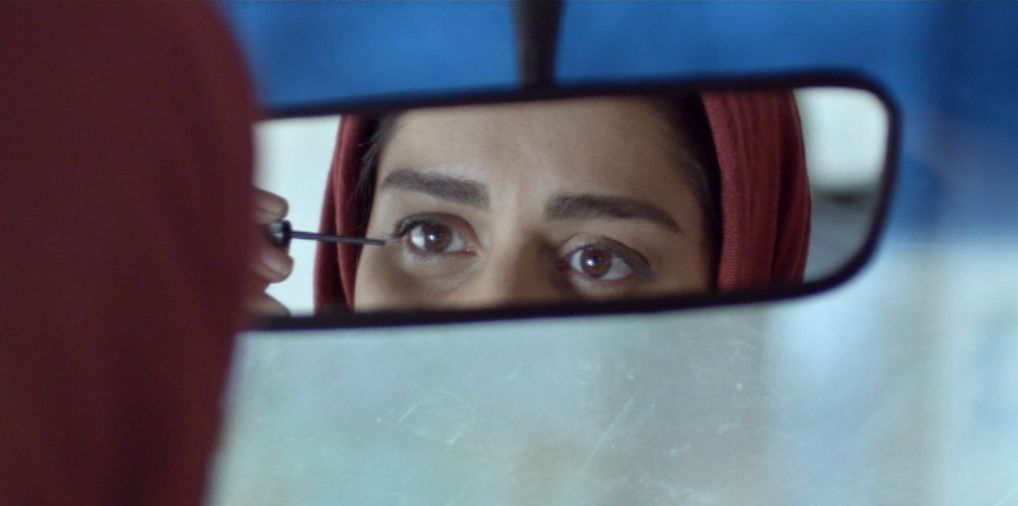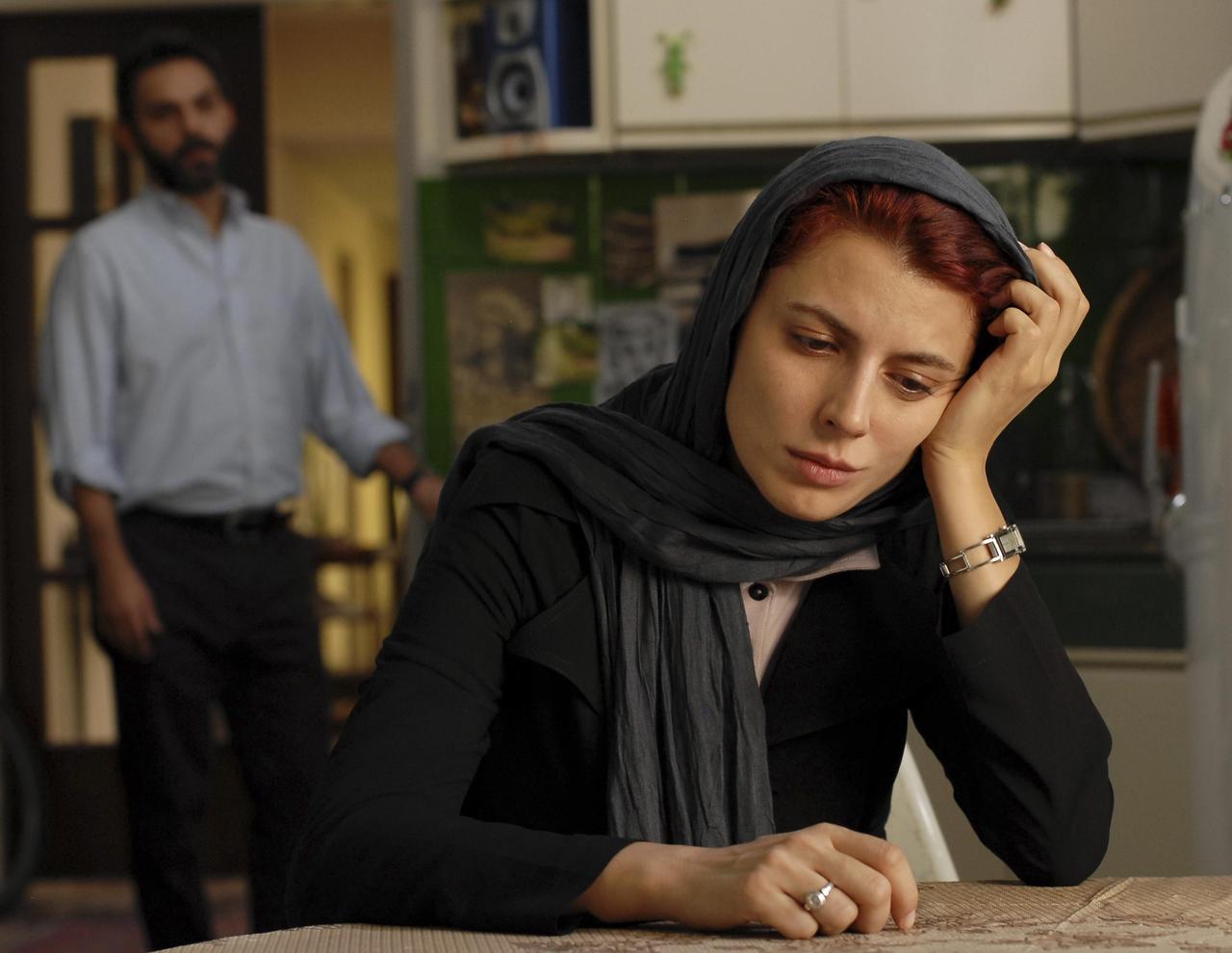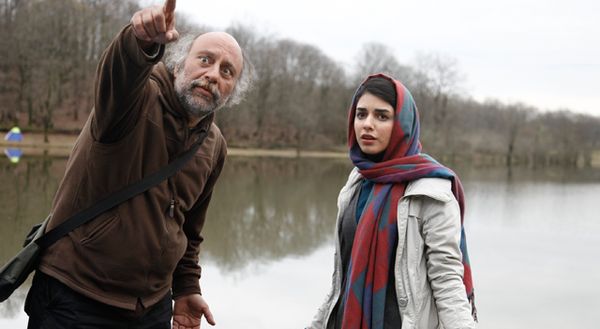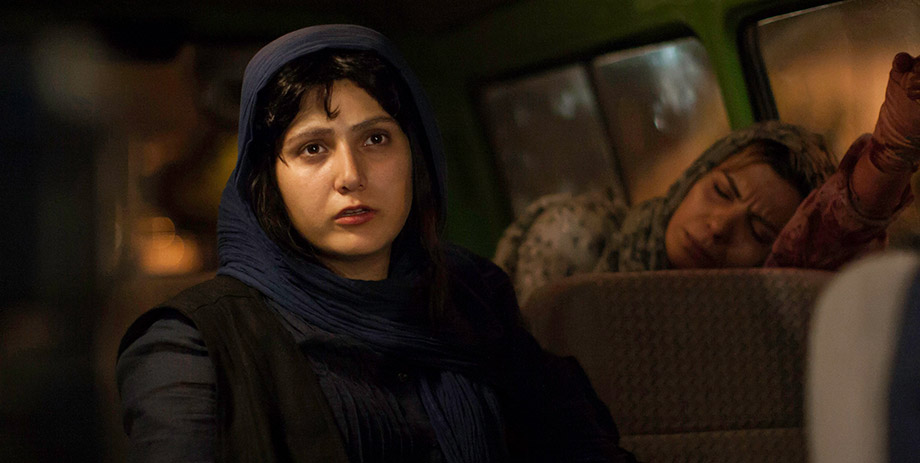6. Facing Mirrors (Negar Azarbayjani, 2011)

Facing Mirrors, set in modern Tehran and its outskirts, is a glimpse into relatively unexplored terrain in the Iranian film industry; the topic of what it means to be transgender. The film follows the story of a chance encounter between two very different women, their individual struggles, and their hesitant friendship.
The film focuses on the headstrong, androgynous Adineh, or “Eddie,” and Rana, a young mother who must work as a cab driver to help make ends meet while she awaits the end of her husband’s prison sentence. Eddie, who plans to undergo gender reassignment surgery and live overseas as a man, manages to convince the unwilling Rana to drive her far north to freedom.
Rana is shocked to learn the truth about her passenger, and initially refuses to have anything more to do with her. However, as she learns more about Eddie, she comes to accept the differences in her new acquaintance.
The film meticulously refuses to conform to gender stereotypes; after all, Rana herself balances the role of both breadwinner and homemaker, thus subverting traditional gender roles in society. Actress Ghazal Shakeri delivers a softly feminine yet strongly determined performance as Rana, while Sheyesteh Irani plays the troubled Eddie with riveting, often touching realism. The strong character development drives the film’s narrative, and both Rana and Eddie are portrayed as fully formed, multifaceted human beings.
Facing Mirrors won Best First Feature at the Frameline Festival, as well as the Grand Prix prize at the LGBT film festival. Hopefully, we will see more of Azarbayjani very soon.
7. A Separation (Asghar Farhadi, 2011)

Perhaps the most acclaimed Iranian film to date, A Separation needs little introduction. The winner of the Best Foreign Language Film at the 2012 Academy Awards, Asghar Farhadi’s work has set new precedents in world cinema.
We are introduced to a Tehran couple at a crossroads in their lives – Simin wishes to leave the country with her family for a better life, while Nader’s first priority is taking care of his father, who suffers from Alzheimer’s. Their resultant separation becomes the catalyst for the events that unfold.
The film’s title does not simply refer to the couple’s marital status, but to the world they live in. Middle class and fairly affluent, Simin and Nader are worlds away from Razieh, the young woman paid to take care of Nader’s invalid father. She feels obligated to keep her work secret from her overbearing husband, but must continue her duties despite being heavily pregnant. Religion and social class serve as sentries that stand between the characters’ worlds.
While it is debatable to what extent Farhadi wishes to provide social commentary in his work, there is no doubt that he succeeds in creating empathy for his characters, who are fully developed and never polarised as ‘good or evil.’ While we may judge them for their decisions and ideologies, we nonetheless want only the best for Simin and Nader. Multi-layered performances from Leila Hatami and Peyman Moadi evoke the complicated love that couples faced with difficult decisions experience, while even the most minor characters are far more nuanced than we would expect.
With Farhadi set to collaborate with Pedro Almodovar in the near future, it seems that his work is garnering the interest of an even wider audience. It will be interesting to see how a more international cast and crew will affect this remarkable filmmaker’s art.
8. Fish and Cat (Shahram Mokri, 2013)

This ambitious work from Shahram Mokri features camera work from A Separation cinematographer Mahmud Kalari and a mainly theatrical cast. However, it is perhaps most notorious for being contained within a single, continuous shot. Supposedly based on a cannibalistic incident in a Northern Iran restaurant, the film combines intense eeriness with the slasher genre.
When a group of students travel to the northern mountains for an annual kite-flying event, they immediately encounter sinister restaurant owners Babak and Saeed at a ramshackle off-road establishment. The owners are made all the more unnerving by their bullying demeanours, and more gruesomely, the blood-soaked bags they carry.
While it would be easy to simply dub the film Iran’s first slasher, this would be somewhat dismissive of the variety of narrative techniques employed by Mokri. As the camera pans from character to character, narration is sometimes experimented with in order to understand the characters’ mindsets.
Alone in the wilderness, each student is thrown into claustrophobic or confusing situations. The pretty Mina is coerced by Babak into entering the forest alone with him, while young buck Parviz discovers that his camping gear has gone missing in his absence. The effect these events have on the young people is an overall, disquieting unease.
The chills do not come from overt gore and violence, but in a gradual build up of dread, formed through chilling descriptive conversation, the mountainous, unfamiliar setting, and a general sense of threat. Some may be tempted to draw parallels between this work and mainstream Hollywood horror; with its bloody color palette, gory backstory, and Special Prize for Innovation at the Venice Film Festival, this film’s calibre cannot be ignored.
9. Melbourne (Nima Javidi, 2014)

“When a character makes choices that are hard to understand, the challenge is to put ourselves in that character’s place. This film compels us to reflect, reminding us to dwell on the ramifications of our own actions. It is an affirmation of how complicated it is to be a responsible human being.”
Director Nima Javidi’s words make it clear that his debut work invites us not to simply react to his astonishing film’s events, but to imagine how we ourselves would fare when faced with the protagonists’ shocking predicament. Melbourne, set almost entirely in one small space, scrutinises how people respond to pressure and tragedy.
Young couple Sara and Amir Negati are caught up in the bustle of packing for a life abroad when we first encounter them, and we learn that they are headed to the titular Australian city to study for several years. Meanwhile, they have been asked to babysit their neighbour’s newborn, who sleeps in the bedroom. The film begins with all the optimism that escaping the daily grind can bring, which contrasts sharply with an opening montage of clothes being vacuum-packed, becoming encased in plastic and drained of life; perhaps an ominous foretelling of what is to occur.
A terrible discovery plunges the couple into a panicked despair, shattering their hopes for a new life and transforming their once airy apartment into a claustrophobic prison. As Amir’s search for a solution to the dilemma borders on insanity, we are forced again and again to wonder whether, placed in the same situation, we wouldn’t behave in the same way. Winner of the Asia Pacific Screen Award and the Stockholm Film Festival, this film’s intense performances and masterful suspense make it essential viewing.
10. Tales (Rakhshan Bani-Etemad, 2014)

Revered as the First Lady in Iranian Cinema,” director Rakhshan Bani-Etemad works around the Iranian culture ministry’s strict licensing laws for feature films by creating several shorts, then piecing them together in this intricate collection of interwoven lives.
Several characters from Bani-Etemad’s past work are present in Tales, and while these films are not essential viewing, seeing how the characters’ lives have panned out since we last glimpsed them adds a certain finality to their stories. We are reunited with Abbas from Under the Skin of the City, now moonlighting as a taxi driver to make ends meet.
We also see his illiterate mother Touba, who, in her struggle to obtain several months’ worth of backpay from her former factory, enlists the help of a petitioner. Bani-Etemad then picks up the story of Nargess, a woman being physically abused by her husband, as well as siblings who wish to fake a kidnapping as an act of rebellion against their wealthy father. The stories, however, stand alone well enough without any prior knowledge of Bani-Etemad’s work.
The director returns to dark themes present in both her earlier and later films, including prostitution, single parenthood, and drug addiction. She does not shy away from the more unsavoury subject matter overlooked by other directors, and the treatment of women in the film does not always make for comfortable viewing – Bani-Etemad does not proclaim to be feminist, and includes scenes in which prostitutes are condemned, abuse victims are pressured to face their attackers, while wives are treated with suspicion by their husbands.
Perhaps the most telling story segment features a documentary filmmaker, who films the streets through Abbas’s taxi window. His insistence on filming his surroundings is telling of Bani-Etemad’s own views. The camera becomes her eye, a lens through which to view her society. Abbas jokes that he should have been filmed, too. “I would have, but you never asked,” replies the filmmaker. In Bani-Etemad’s world, society asks to be filmed, without waiting for licenses or invitations. Winner of the Venice International Film Festival for Best Screenplay, Tales represents a collage of contemporary Iran’s grittier side.
Author Bio: Zara Knox is a creative writer for IMVBox, the largest online Persian film distribution platform outside of Iran. To see more of her work and watch thousands of Iranian films for free, visit www.imvbox.com.